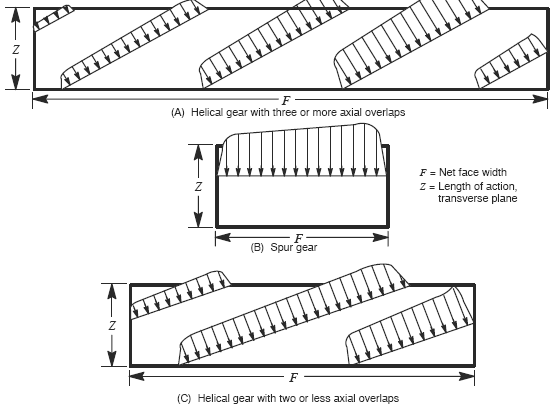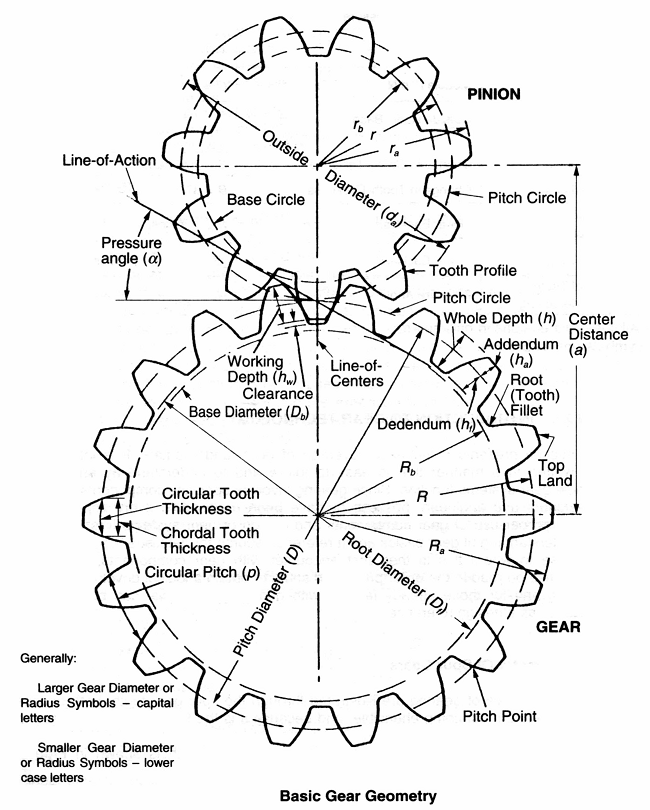Related Resources: calculators
Gear Tooth Contact Stress Number Equation and Calculator
AGMA Contact Stress Number Formula for Gear Tooth Equation and Calculator
Per standard ANSI/AGMA D04 Fundamental Rating Factors and Calculation Methods for Involute Spur and Helical Gear Teeth:
The purpose of AGMA and ANSI standards is to establish a common base for rating various types of gears for differing applications, and to encourage the maximum practical degree of uniformity and consistency between rating practices within the gear industry. It provides the basis from which more detailed AGMA application standards are developed, and provides a basis for calculation of approximate ratings in the absence of such standards.
The formulas presented contain factors whose values vary significantly depending on application, system effects, gear accuracy, manufacturing practice, and definition of gear failure. Proper evaluation of these factors is essential for realistic ratings. The AGMA/ANSI standards is intended for use by the experienced gear designer capable of selecting reasonable values for rating factors and aware of the performance of similar designs through test results or operating experience.
The intent of the AGMA strength rating formula is to determine the load which can be transmitted for the design life of the gear drive without causing root fillet cracking.
Preview premium Membership access calculator: AGMA Contact Stress Number Formula for Gear Teeth Calculator
The contact stress number formula for gear teeth is:
Eq. 1
sc = Cp [ Wt Ko Kv Ks Km / ( d F ) Cf / I ]0.5
where:
sc = contact stress number, lb/in2;
Cp = elastic coefficient, [lb/in2]0.5
Wt = transmitted tangential load, lb;
Ko = overload factor;
Kv = dynamic factor;
Ks = size factor;
Km = load distribution factor;
Cf = surface condition factor for pitting resistance;
F = net face width of narrowest member, in;
I = geometry factor for pitting resistance;
Eq. 2
d = operating pitch diameter of pinion, in.
for external gears
d = 2C / ( mG + 1 )
Eq. 3
for internal gears
d = 2C / ( mG - 1 )
where:
C = operating center distance, in;
mG = gear ratio (never less than 1.0).
elastic coefficient Cp is defined by the following;
Eq. 4
Cp = [ 1 / { π [ ( ( 1 - µ2P ) / EP ) + ( ( 1 - µ2G ) / EG ) ] } ](1/2)
Cp = elastic coefficient, [lb / in2](1/2);
µP and µG is Poisson’s ratio for pinion and gear, respectively;
EP and EG is modulus of elasticity for pinion and gear, respectively, lb/in2.
For example, Cp equals 2300 [lb/in2](1/2), for a steel pinion and gear with µ = 0.3 and E = 3 x 107 lb/in2 for both members.
Transmitted tangential load, Wt
Eq. 5
Wt = 33,000 P / vt = 2 T / d = 396,000 P / ( π np d )
where:
P = transmitted power, hp;
T = transmitted pinion torque, lb in;
vt = pitch line velocity at operating pitch diameter, ft/min.
where;
Eq. 6
vt = π np d / 12
Notes:
Overload factor, Ko is intended to account for the operating characteristics of the driving and driven equipment. It must be recognized, however, that if the operating roughness of the driver, gearbox, or driven equipment causes an excitation with a frequency that is near to one of the system’s major natural frequencies, resonant vibrations may cause severe overloads which may be several times higher than the nominal load. For more information, refer to ANSI/AGMA 6011-I03, Specification for High Speed Helical Gear Units, Annex D.
Dynamic factor, Kv accounts for internally generated gear tooth loads which are induced by non-conjugate meshing action of the gear teeth. Even if the input torque and speed are constant, significant vibration of the gear masses, and therefore dynamic tooth forces, can exist. These forces result from the relative accelerations between the gears as they vibrate in response to an excitation known as “transmission error”. Ideally, a gear set would have a uniform velocity ratio between the input and output rotation. Transmission error is defined as the departure from uniform relative angular motion of the pair of meshing gears. It is influenced by all the deviations from the ideal gear tooth form and ideal spacing. Dynamic factor, Kv, has been redefined as the reciprocal of that used in previous AGMA standards. It is now greater than 1.0. In earlier AGMA standards it was less than 1.0. (Approximate dynamic factor - see bottom of webpage).
The dynamic factor relates the total tooth load including internal dynamic effects to the transmitted tangential tooth load.
Eq. 7
Kv = ( Fd + Ft ) / Ft
where:
Fd = incremental dynamic tooth load due to the dynamic response of the gear pair to the transmission error excitation, not including the transmitted tangential load, lbs.
Ft = tooth load
Size factor Ks reflects non-uniformity of material properties. It depends primarily on:
- Tooth size
- Diameter of parts
- Ratio of tooth size to diameter of part
- Face width
- Area of stress pattern
- Ratio of case depth to tooth size
- Hardenability and heat treatment of materials
- Standard size factors for gear teeth have not yet been established for cases where there is a detrimental size effect. In such cases, some size factor greater than unity should be used.
Km = load distribution factor is defined as: the peak load intensity divided by the average, or uniformly distributed, load intensity; i.e., the ratio of peak to mean loading.
The load distribution factor modifies the rating equations to reflect the non--uniform distribution of the load along the lines of contact. The amount of non--uniformity of the load distribution is caused by, and is dependent upon, the following influences:
Manufacturing variation of gears
-- Lead, profile, spacing and runout of both the pinion and the gear.
-- Tooth crowning and end relief.
Assembly variations of installed gears
-- Alignment of the axes of rotation of the pitch cylinders of the pinion and gear as influenced by housing accuracy and concentricity of the bearings.
Deflections due to applied loads
-- Elastic deflections of the pinion and gear teeth.
-- Elastic deflections of the pinion and gear bodies.
-- Elastic deflections of shafts, bearings, housings and foundations that support the gear elements.
-- Displacements of the pinion or gear due to clearance in the bearings.
Distortions due to thermal and centrifugal effects
-- Thermal expansion and distortion of the gears due to temperature gradients.
-- Temperature gradients in the housing causing nonparallel shafts.
-- Centrifugal distortion of the gears due to high speeds.
Its magnitude is affected by two components:
Cmf = face load distribution factor;
Cmt = transverse load distribution factor.
Cmf and Cmt can be interrelated depending on the form of the instantaneous contact line in the plane of action as shown by figure 1. In functional equation form,
Eq. 8
Km = f ( Cmf - Cmt )

Figure 1 load distribution factor
Approximate dynamic factor, Kv Figure 2 shows dynamic factors which can be used in the absence of specific knowledge of the dynamic loads. The curves of figure 1 and the equations given are based on empirical data, and do not account for resonance.
Due to the approximate nature of the empirical curves and the lack of measured tolerance values at the design stage, the dynamic factor curve should be selected based on experience with the manufacturing methods and operating considerations of the design.

Figure 2 - dynamic factor Kv, click on image to enlarge
The surface condition factor, Cf, used only in the pitting resistance formula, depends on:
-- Surface finish as affected by, but not limited to, cutting, shaving, lapping, grinding, shot peening;
-- Residual stress;
-- Plasticity effects (work hardening).
Standard surface condition factors for gear teeth have not yet been established for cases where there is a detrimental surface finish effect. In such cases, some surface finish factor greater than unity should
be used.
The surface condition factor can be taken as unity provided the appropriate surface condition is achieved.
The geometry factor, I, evaluates the radii of curvature of the contacting tooth profiles based on tooth geometry. These radii are used to evaluate the Hertzian contact stress in the tooth flank. Effects of modified tooth proportions and load sharing are
considered.

Figure 3 Basic Gear Pinion Configuration (Click on image to enlarge)
Related:
- Spur Gear Generator with Download Spur Gear Generator is unitless: you may choose inches, cm or millimeters when importing your DXF file as you will have the same value for D/P as it is set above or as imported (SI or imperial units).
- Spur Gear and Assembly Builder Spur Gear and Assembly Builder calculates and models individual Spur Gears and Gear assembly. File down loads available with Premium Account.
- Gear Design Handbook Premium Membership Required
- AGMA Spur Gear Profile Calculator Spread Sheet - Three excel calculation sheets that include the following input data/variables, calculated data and chart graphics.
- AGMA Worm and Spur Gear Design Equations and Calculators Worm gear sets are generally rated by their capacity to handle a particular level of input power, output power, or allowable torque at a particular speed for the input or output shaft.
- AGMA Worm gear Equations For Rating Factors Values for the ratio correction factor, the velocity factor, and materials factors can be found from tables provided in the ANSI/AGMA 6034-B92 standard.
- Practical Gear Design and Manufacture Handbook 872 pages, Premium account required, Gears are produced in enormous amounts - billions of gears are produced by industries every year. While the automotive industry ranks as the primary consumer of gears, numerous other industries also require huge amounts of gears: aerospace (helicopter transmission, etc. ), construction machinery, and agricultural machinery, to name a few.
- AGMA Fine Pitch Tolerances for Gears Gear tolerance chart below, lists the more common tolerance or quality specifications assigned for Spur, Helical and Herringbone type gears. Source:
ANSI/AGMA American Nation Standards Institutue . American Gear Manufacturers Association